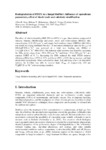Biodegradation of BTEX in a fungal biofilter: Influence of operational parameters, effect of shock-loads and substrate stratification

Use this link to cite
http://hdl.handle.net/2183/13693Collections
- Investigación (FCIE) [1227]
Metadata
Show full item recordTitle
Biodegradation of BTEX in a fungal biofilter: Influence of operational parameters, effect of shock-loads and substrate stratificationDate
2012-07Citation
Rene ER, Mohammad BT, Veiga MC, Kennes C. Biodegradation of BTEX in a fungal biofilter: Influence of operational parameters, effect of shock-loads and substrate stratification. Bioresour Technol. 2012;116:204-13.
Abstract
The effect of relative humidity (RH: 30% to >95%) of a gas-phase mixture composed of benzene, toluene, ethylbenzene and para-, meta- and ortho-xylenes (BTEX), inlet concentrations (0.2–12.6 g m−3), and empty bed residence times (EBRTs) (48–144 s) was tested in a fungi-dominant biofilter. A maximum elimination capacity (ECmax) of 244.2 gBTEX m−3 h−1 was achieved at a total inlet loading rate (ILRT) of 371.2 gBTEX m−3 h−1 (RH: 65%). The transient-state response was tested by increasing the ILRT, in two steps, from ∼50 to 850 g m−3 h−1 and from ∼50 to 320 g m−3 h−1, at a constant EBRT of 41.7 s. Increasing the ILRT reduced the total BTEX removal efficiency (RET) from >97% to 35%, and from >90% to 60% during medium and high shock-load, respectively. When subjected to short (4 d) and long-term (7 d) shut-down periods, the biofilter was able to recover high ECmax of, respectively, 200 and 72 gBTEX m−3 h−1 after resuming operation.
Keywords
Fungi
Relative humidity
pH
Gas to liquid (G/L) ratio
Transient operations
Relative humidity
pH
Gas to liquid (G/L) ratio
Transient operations





